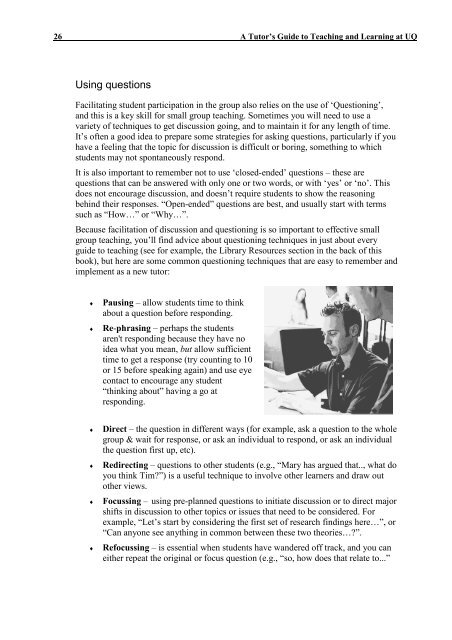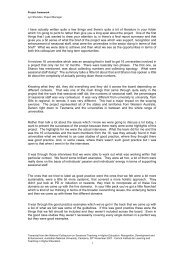A tutor's guide to teaching and learning at UQ - TEDI - University of ...
A tutor's guide to teaching and learning at UQ - TEDI - University of ...
A tutor's guide to teaching and learning at UQ - TEDI - University of ...
Create successful ePaper yourself
Turn your PDF publications into a flip-book with our unique Google optimized e-Paper software.
26 A Tu<strong>to</strong>r’s Guide <strong>to</strong> Teaching <strong>and</strong> Learning <strong>at</strong> <strong>UQ</strong>Using questionsFacilit<strong>at</strong>ing student particip<strong>at</strong>ion in the group also relies on the use <strong>of</strong> ‘Questioning’,<strong>and</strong> this is a key skill for small group <strong>teaching</strong>. Sometimes you will need <strong>to</strong> use avariety <strong>of</strong> techniques <strong>to</strong> get discussion going, <strong>and</strong> <strong>to</strong> maintain it for any length <strong>of</strong> time.It’s <strong>of</strong>ten a good idea <strong>to</strong> prepare some str<strong>at</strong>egies for asking questions, particularly if youhave a feeling th<strong>at</strong> the <strong>to</strong>pic for discussion is difficult or boring, something <strong>to</strong> whichstudents may not spontaneously respond.It is also important <strong>to</strong> remember not <strong>to</strong> use ‘closed-ended’ questions – these arequestions th<strong>at</strong> can be answered with only one or two words, or with ‘yes’ or ‘no’. Thisdoes not encourage discussion, <strong>and</strong> doesn’t require students <strong>to</strong> show the reasoningbehind their responses. “Open-ended” questions are best, <strong>and</strong> usually start with termssuch as “How…” or “Why…”.Because facilit<strong>at</strong>ion <strong>of</strong> discussion <strong>and</strong> questioning is so important <strong>to</strong> effective smallgroup <strong>teaching</strong>, you’ll find advice about questioning techniques in just about every<strong>guide</strong> <strong>to</strong> <strong>teaching</strong> (see for example, the Library Resources section in the back <strong>of</strong> thisbook), but here are some common questioning techniques th<strong>at</strong> are easy <strong>to</strong> remember <strong>and</strong>implement as a new tu<strong>to</strong>r:♦♦Pausing – allow students time <strong>to</strong> thinkabout a question before responding.Re-phrasing – perhaps the studentsaren't responding because they have noidea wh<strong>at</strong> you mean, but allow sufficienttime <strong>to</strong> get a response (try counting <strong>to</strong> 10or 15 before speaking again) <strong>and</strong> use eyecontact <strong>to</strong> encourage any student“thinking about” having a go <strong>at</strong>responding.♦♦♦♦Direct – the question in different ways (for example, ask a question <strong>to</strong> the wholegroup & wait for response, or ask an individual <strong>to</strong> respond, or ask an individualthe question first up, etc).Redirecting – questions <strong>to</strong> other students (e.g., “Mary has argued th<strong>at</strong>.., wh<strong>at</strong> doyou think Tim?”) is a useful technique <strong>to</strong> involve other learners <strong>and</strong> draw ou<strong>to</strong>ther views.Focussing – using pre-planned questions <strong>to</strong> initi<strong>at</strong>e discussion or <strong>to</strong> direct majorshifts in discussion <strong>to</strong> other <strong>to</strong>pics or issues th<strong>at</strong> need <strong>to</strong> be considered. Forexample, “Let’s start by considering the first set <strong>of</strong> research findings here…”, or“Can anyone see anything in common between these two theories…?”.Refocussing – is essential when students have w<strong>and</strong>ered <strong>of</strong>f track, <strong>and</strong> you caneither repe<strong>at</strong> the original or focus question (e.g., “so, how does th<strong>at</strong> rel<strong>at</strong>e <strong>to</strong>...”



